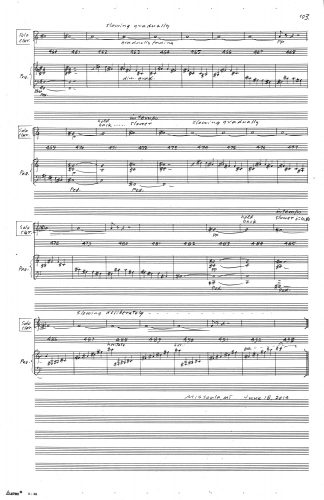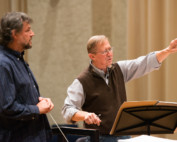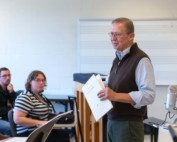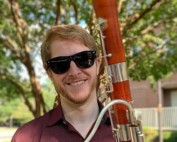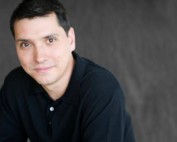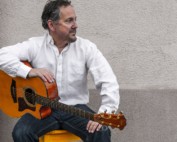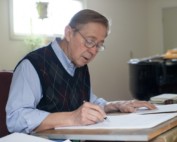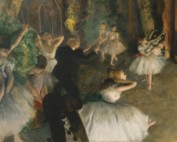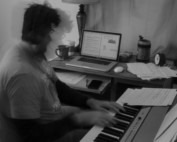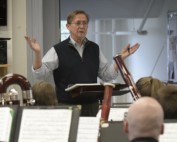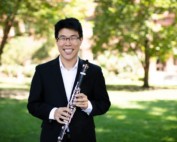Project Description
Solo Clarinet and Wind Ensemble
2014
25 min.
Grade 6
Listen Now
Myroslava Hagen, clarinet, University Of Utah Wind Ensemble, Scott Hagen, cond.. On the album The Music Of David Maslanka, Vol. 2 (2016)
Dawn Lindblade, clarinet, University of Central Oklahoma Wind Ensemble, Brian Lamb, cond.
Myroslava Hagen, Clarinet, University of Utah Wind Symphony, Scott Hagen, cond.
Premiere Performance: 26 February 2015, Libby Gardener Concert Hall at the University of Utah
Instrumentation
Solo Cl Picc Fl-2(2»AFl) Ob-2 BbCl-2 BCl CbCl Bsn-2 SSx ASx TSx BSx Hn-2 Tpt-2 Tbn-2 Euph Tuba DB Pno Timp Perc-5
- Solo Clarinet in B♭
- Piccolo
- Flute (2) (2 doubles Alto Flute)
- Oboe (2)
- Clarinet in B♭ (2)
- Bass Clarinet in B♭
- Contrabass Clarinet in B♭
- Bassoon (2)
- Soprano Saxophone
- Alto Saxophone
- Tenor Saxophone
- Baritone Saxophone
- Horn in F (2)
- Trumpet in B♭ (2)
- Trombone (2)
- Euphonium
- Tuba
- Double Bass
- Piano
- Timpani
- Required Percussion (5 players)
- Vibraphone
- Marimba
- Suspended Cymbal (lg.)
- Crotales
- Hi-hat Cymbal
- Xylophone
- Tam-tam
- Bass Drum
- Wood Blocks (1 sm., 1 lg.)
- Glockenspiel
- Snare Drum (1 sm., 1 med.)
- Bass Drum
- Triangle (lg.)
Movements
- Lamentation
- Dance
Commissioned by
Premiere
Description
The expressive antecedents are more Romantic – composers such as Franz Liszt and Carl Maria von Weber – powerful expression and a ripping-good technical challenge for the soloist.
Program Note 1
The Romantic elements are in the qualities of expression. I have long counted Franz Liszt as a spiritual ancestor, and as a young clarinetist I made my way through the concerto pieces of Carl Maria von Weber – lots of notes, speed, and powerful personal expression in both these composers.
And yet this is very much a piece of our time. We are going through a major world change, possibly the major world change, with technological advances whipping us along at incredible speeds. With the advent of instant communication and information we are at last beginning to see and understand the human race as one entity, and in immediate relationship with the rest of creation. This huge shift requires intense dream time, especially conscious dream time, and music powerfully opens this dream space. “Lamentation:” a deep mourning as we view our personal troubles, and the troubles of the world; “Dance:” a springing leap forward into a new world.
Program Note by David Maslanka
Program Note 2
This concerto is full of deep feeling, but it does not have a personal story. The two movements, “Lamentation” and “Dance,” present the classic masks of tears and laughter. “Lamentation” is very interior and very beautiful – it breaks my heart. “Dance” unfolds in the old sonata form with clear melodies, a bubbling and sometimes urgent energy, and a final release into beautiful quiet.
Program Note by David Maslanka
Further Reading
Rehearsing Alex and the Phantom Band and Saint Francis: Middle Tennessee State University (Oct 2016)
In October 2016, I (Matthew Maslanka) accompanied my father to Middle Tennessee State University where I photographed and recorded his masterclasses and rehearsals. This is his rehearsal on October 25. He helped produce his final [...]
Masterclass: Middle Tennessee State University (Oct 2016)
In October 2016, I (Matthew Maslanka) accompanied my father to Middle Tennessee State University where I photographed and recorded his masterclasses and rehearsals. This is his first masterclass, on October 24. He helped produce his [...]
From the Maslanka Archive – No. 37, Conor Bell’s New Dissertation on David’s Bassoon Music
From the Maslanka Archive features media and stories of David's life and work. This week, we are excited to feature Conor Bell's new dissertation on David's Bassoon Music.
From the Maslanka Archive – No. 36, Anthony Joseph Lanman’s Interview of Matthew
From the Maslanka Archive features media and stories of David's life and work. This week, we are excited to feature Anthony Joseph Lanman's interview with Matthew on his podcast, 1 Track from Matthew's home in New York, NY earlier this year.
Interview with Tiffany Woods (2003)
In May 2003, Tiffany Woods emailed David a series of questions in the course of writing a paper. She was a student at the University of North Carolina Greensboro and taking a Band Literature course [...]
From the Maslanka Archive – No. 35, Damon Talley’s Interview of David
From the Maslanka Archive features media and stories of David's life and work. This week, we are excited to feature one of David's very last interviews. In April of 2017, Damon Talley - Director of Bands at LSU - had the opportunity to sit down with David and discuss Symphony No. 4 during a residency with the LSU Wind Ensemble.
From the Maslanka Archive – No. 33, John Floridis’s Interview of David
From the Maslanka Archive features media and stories of David's life and work. This week, we are excited to feature an episode from Montana Public Radio's Musician's Spotlight featuring John Floridis interviewing David about his music and background as a composer.
From the Maslanka Archive – No. 32, Julian Velasco’s Interview of David – Part 2
From the Maslanka Archive features media and stories of David's life and work. This week, we are excited to feature Part 2 of Julian Velasco's interview of David from his home in Missoula, MT in 2016.
From the Maslanka Archive – No. 31, Julian Velasco’s Interview of David – Part 1
From the Maslanka Archive features media and stories of David's life and work. This week, we are excited to feature Part 1 of Julian Velasco's interview of David from his home in Missoula, MT in 2016.
From the Maslanka Archive – No. 30, Jim Tevenan’s Interview of David
From the Maslanka Archive features media and stories of David's life and work. This week, we are excited to feature an episode from Spokane Public Radio's From The Studio featuring Jim Tevenan interviewing David about his music. The Whitworth Wind Symphony had just performed David's Symphony No. 4.
From the Maslanka Archive – No. 27, David on Composition and the Creative Process
From the Maslanka Archive features media and stories of David's life and work. his week, we are excited to feature an interview David gave to BizMontana on matters of composition and the creative process.
Maslanka Weekly: Best of the Web – No. 106, Dances
Maslanka Weekly highlights excellent performances of David Maslanka’s music from around the web. This week, we feature three compositions in which David experiments with dance forms: Montana Music: Three Dances for Percussion, Concerto for Clarinet and Wind Ensemble, and Concerto No. 2 for Piano and Wind Ensemble.
From the Maslanka Archive – No. 14, Letter for Kevin Krumenauer
From the Maslanka Archive features media and stories of David's life and work. This week, we are excited to feature a letter of recommendation written by David for composer Kevin Krumenauer in 2007.
Maslanka Weekly: Best of the Web – No. 65, Lamentations
Maslanka Weekly highlights excellent performances of David Maslanka’s music from around the web. This week, we feature three of David’s compositions that contain the feeling of lament: Concerto for Clarinet and Wind Ensemble, Hohner, and Symphony No. 3.
Maslanka Weekly: Best of the Web – No. 59, Music For David
Maslanka Weekly highlights excellent performances of David Maslanka’s music from around the web. This week, we feature three works by composers who have dedicated music to David and his memory: "After Maslanka" from Tribute Trio by Russell Peterson, Funeral Song for David Maslanka by Andrew Bockman, and Montis - Tribute to David Maslanka by Elliott Sorenson.
Maslanka Weekly: Best of the Web – No. 35, David Maslanka – The Composition Teacher
Maslanka Weekly highlights excellent performances of David Maslanka’s music from around the web. This week, we take a look at three of the many pupils David worked with over the years as well as one of their compositions: Symphony No. 3, "For David" by Kimberly K. Archer, This is Our Joyful Hour by Kevin Krumenauer, and Heroes from the Sea by Onsby C. Rose.
Maslanka Weekly: Best of the Web – No. 30, David’s Wisdom
Maslanka Weekly highlights excellent performances of David Maslanka’s music from around the web. This week, we take a special look at David's philosophies on music, the creative process, and creating peace through musical tones.
Maslanka Weekly: Best of the Web – No. 29, Remembering David
Maslanka Weekly highlights excellent performances of David Maslanka’s music from around the web. We start the beginning of 2019 by taking time to remember the life and music of David Maslanka.
Maslanka Weekly: Best of the Web – No. 12, The Clarinet
Maslanka Weekly highlights excellent performances of David Maslanka’s music from around the web. This week, fantastic performances of Concerto for Clarinet and Wind Ensemble, Little Symphony on the name BArnEy CHilDS, and Desert Roads: Four Songs for Clarinet and Wind Ensemble.
8 Questions for David Maslanka
The following is from an email exchange with Natasha Rotondaro, a grade 12 student from Emily Carr Secondary School in Vaughn, Ontario Natasha Rotondaro: What is your musical background? David Maslanka: I began clarinet studies [...]
Thoughts on Composing
Excerpts from letters to young composers You ask about the soul nature of music, and are music and soul the same thing. Music is one of the expressions of soul. A person does not have [...]
Interview with Russell Peterson
Russell Peterson, professor of saxophone at Lawrence University in Appleton WI, interviewed David Maslanka on 30 November 1998 after premieres of Mountain Roads for saxophone quartet, commissioned and performed by the Transcontinental Saxophone Quartet and [...]
Composing and its relationship to the community
I want to talk a bit about the composing process and its relationship to community. I have recently been reading Gerard Manley Hopkins, the great nineteenth-century English poet. Hopkins speaks of the “particularity” of each [...]
